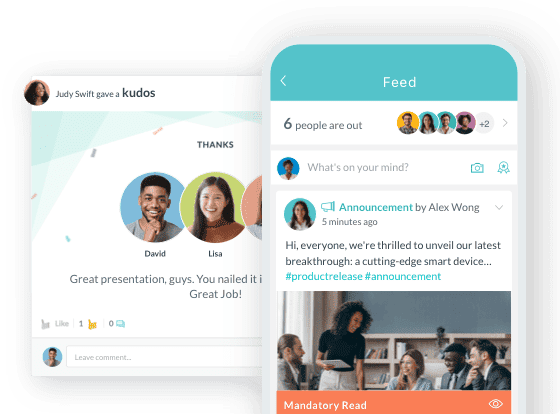The Ultimate Guide to a Smooth Employee Onboarding Process in 2025
.png)
- Why Does Employee Onboarding Matter in 2025?
- What Is Employee Onboarding?
- Why a Smooth Onboarding Process Matters
- Step-by-Step Guide to a Smooth Onboarding Process
- Use of Technology Enhances the Onboarding Experience
- Top Employee Onboarding Best Practices
- Common Onboarding Mistakes and How to Avoid Them
- Employee Onboarding Checklist & Template
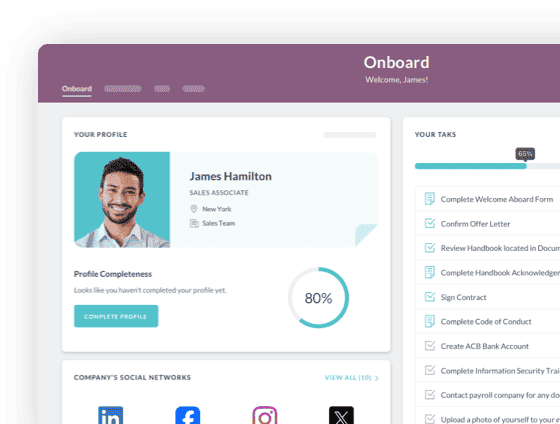
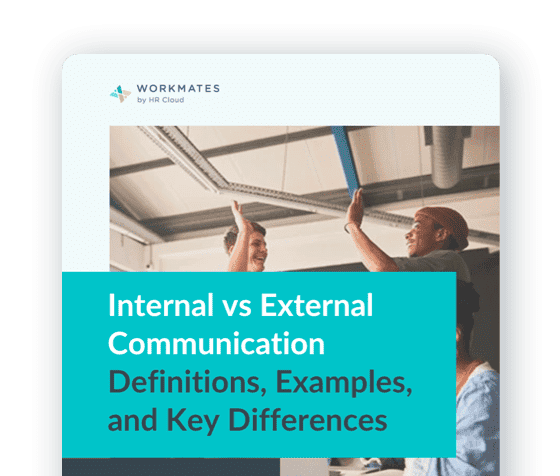
 Cut onboarding time
by 60%—here's the
Ultimate Checklist
that helped do it.
Cut onboarding time
by 60%—here's the
Ultimate Checklist
that helped do it.
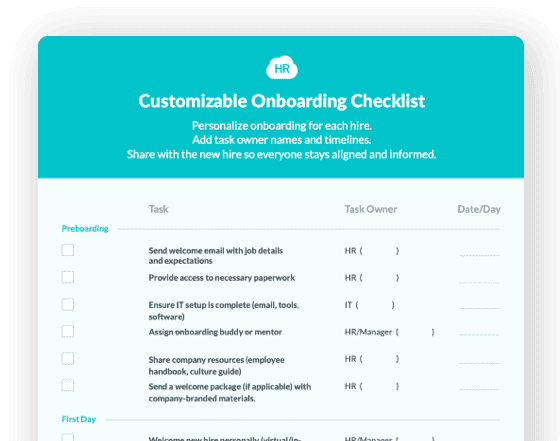
You can also listen to this blog
Bringing in a new employee isn’t just about paperwork and first-day introductions. According to HBR, a well-structured onboarding process can increase new hire retention by up to 50% among the new hires and boost productivity by over 62% within the same group. Yet, many companies still struggle to allocate sufficient time and resources to create a smooth employee onboarding process, leaving employees overwhelmed and disengaged.
Why Does Employee Onboarding Matter in 2025?
As the landscape of the working environment matures (think fully remote, flexi, on-site, and more), employee onboarding is evolving too. It has moved beyond being just an administrative process to be gotten out of the way on the first day of a new hire. In 2025, the onboarding experience needs to be an engaging, structured, and tech-enabled experience, irrespective of whether you are onboarding in-person or virtually.
What You’ll Learn in This Guide
This ultimate guide will walk you through:
-
What is employee onboarding
-
Why a smooth onboarding process matters
-
A step-by-step framework for a smooth onboarding process
-
First day: Making a strong first impression
-
First month: Building confidence and engagement
-
Ongoing integration (first 3-6 months)
-
Use of technology enhances the onboarding experience
-
Measuring onboarding success: Key Metrics & KPIs
-
Top employee onboarding best practices
-
Common onboarding mistakes and how to avoid them
-
Employee onboarding checklist and template
-
How to optimize remote onboarding
-
Key metrics to measure onboarding success
What Is Employee Onboarding?
Employee onboarding is the process of integrating a new hire into a company, ensuring they have the knowledge, tools, and connections needed to succeed in their role. It goes beyond administrative tasks like signing contracts, setting up emails and allocating a parking lot. It includes cultural assimilation, role-specific training, and long-term engagement strategies.
A well-executed onboarding process should help employees feel welcome, confident, and prepared from day one, increasing their chances of long-term success.
How Employee Onboarding Differs from Orientation
If you sometimes get confused between employee orientation vs employee onboarding, let’s get that out of the way first.
Employee orientation is a one-time event that covers paperwork, policies, and company introductions. Employee onboarding, on the other hand, is a structured process that spans weeks or even months, ensuring that new hires fully integrate into their roles and the company culture.
Why a Smooth Onboarding Process Matters
A strong onboarding experience isn't just about making a good first impression. It directly impacts retention, productivity, and overall company success. When employees feel welcomed, informed, and supported from day one, they are more likely to be engaged and committed to their roles. In contrast, a poor onboarding experience can lead to confusion, disengagement, and early turnover. According to the 2022 Job SeekerNation Report, 30% of employees leave jobs within 90 days.
Data shows that companies that invest in a structured onboarding process benefit in several key ways:
-
Higher Retention Rates: Employees are 58% more likely to stay with a company for three years or more when they have a structured onboarding experience. (Clickboard)
-
Increased Productivity: As mentioned at the beginning of the guide, organizations with standardized onboarding processes see 50% greater new-hire productivity.
-
Improved Employee Engagement: Employees who have a great onboarding experience are 2.6 times more likely to be "extremely satisfied" at work (Gallup).
-
Reduced Turnover Costs: Hiring and training a new employee is expensive. Studies put the cost at anywhere from almost $5k to 6-9 times the employee’s salary. A smooth onboarding experience lowers the early turnover rate, increasing chances of long-time retention.
-
Faster Integration and Performance: Effective onboarding ensures that new hires quickly understand their responsibilities, company culture, and growth opportunities. Which further helps them ramp up quickly and contribute to business success.
Onboarding isn't just an HR responsibility. All stakeholders, right from the senior management to the team lead and direct-in-line managers must be a part of the process. Let us break down each phase of onboarding to create an uncomplicated end-to-end employee onboarding process.
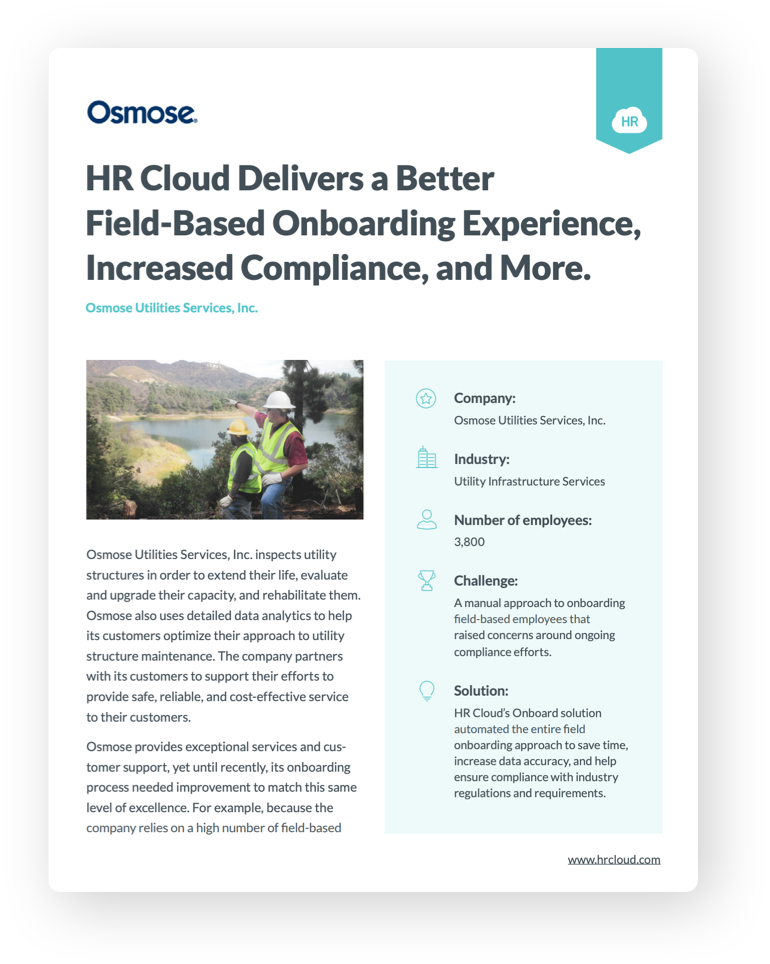
Step-by-Step Guide to a Smooth Onboarding Process
To create a smooth onboarding experience, you should break it down into structured phases. Each phase plays a critical role in ensuring employees receive the right support and training at the right time. A formal onboarding process typically includes the following four steps:
-
1. Preboarding (Before Day 1)
-
2. First Day: Making a Strong First Impression
-
3. First Month: Building Confidence and Engagement
-
4. Ongoing Integration (First 3-6 Months)
By structuring onboarding into these phases, you can create a seamless transition for new hires, increasing their confidence, engagement, and long-term commitment. We will get to the details of how to do this in a bit; let’s first talk about why you need the employee onboarding process to be smooth and engaging.
Preboarding: Onboarding Starts Before Day 1
Most companies think onboarding begins on an employee’s first day. In reality, it starts much earlier — from the moment a candidate applies for a job. The hiring and interview experience can set the stage for what new hires expect in their roles. In fact, that can affect whether they finally accept the offer at all. A smooth, transparent, and engaging recruitment process reassures candidates that they’re making the right decision in choosing to work with you.
How the Hiring Experience Shapes Onboarding
-
Clear Job Descriptions and Expectations: Yes, the onboarding process starts with providing an accurate job description. It helps candidates understand what they will be expected to accomplish if the hiring happens. When expectations are clearly defined, new hires can transition smoothly into their roles. Research shows that poor job description aka lack of clarity in job profile leads to early turnover.
-
A Positive Interview Experience: Candidates who experience organized, respectful, and transparent interviews are more likely to feel excited about joining. Delays, lack of communication, or overly complicated hiring processes can create frustration, reducing engagement before onboarding even starts.
-
Engaging Candidates Between Offer and Start Date: Once a candidate accepts the offer, you should keep communication open to maintain enthusiasm. Studies show that cold silence between an offer and the start date increases the risk of no-shows on Day 1.
Preboarding: Setting the Stage Before Day 1
As per Indeed data 83% of surveyed employers reported being ghosted during the hiring process. And out of this, 22% accepted the offer but did not show up on the first day. So, you need preboarding to ensure new hires feel informed and welcome before their official start date.
Even experienced professionals have those first-day anxieties because they are unfamiliar with the company, its culture, and its people. For first time employees, add confusion, lack of professional experience and social anxieties to the mix. An engaging and empathetic preboarding experience can help reduce these vulnerabilities.
Key Strategies for Effective Preboarding:
Here are a few ways you can make the new hires feel comfortable and valued even before they join.
-
Send a Personalized Welcome Message: Reach out with a warm, personalized email expressing how excited you are to welcome them. This simple gesture will make them look forward to Day 1 rather than feel jittery about it. Okay, they might still get the first-day jitters, but considerably less so.
-
Provide Essential Documentation in Advance: It’s a good idea to share necessary paperwork, such as tax forms, contracts, and company policies, before the start date. It allows new employees to review documents at their convenience, making their first day more relaxed.
-
Share Company Resources and Information: You can offer access to the employee handbook, organizational chart, and introductory materials about company culture and values. This helps them familiarize themselves with these crucial details and feel more comfortable on Day 1.
-
Prepare the Workstation and Tools: Scrambling to get the new hire’s workspace, hardware, and cloud access in place after their arrival has a two-pronged effect. One, it paints your organization in a poor light. Two, it adds to their anxiety due to the fear of the unknown.
Pro Tip: For remote employees, coordinate the timely delivery of hardware and provide clear setup instructions.
-
Assign a Mentor or Buddy: Pairing new hires with an experienced team member provides immediate support, answers questions, and eases the transition into company culture. The majority of first-day jitters arise from fear of the unknown; they do not know what will happen on ground zero. Having someone to guide them through the initial hiccups can go a long way in integrating them to the company culture that much quicker.
-
Send a Welcome Package: A thoughtful preboarding touch can increase new hire engagement. Consider sending a welcome kit with company-branded merchandise, USB sticks, backpacks or tote bags, desk nameplates, etc. to make them look forward to Day 1. The welcome kit plays an even more crucial role when onboarding remote employees.
-
Communicate the First-Day Agenda: Provide a detailed schedule outlining meetings, training sessions, and key activities for the first day and week. Mention who all would be joining the sessions and the location. Clarity reduces first-day uncertainty and makes the onboarding process smoother.
-
Engage Early with Team Introductions: You can share team bios or set up informal virtual meet-and-greets before the official start date. Early introductions help new hires establish workplace relationships with their colleagues before Day 1.
By focusing on both preboarding and the hiring experience, you can ensure new hires arrive on Day 1 feeling excited, prepared, and engaged.
.png?width=482&height=1034&name=Green%20Clean%20Wellness%20Programs%20for%20Corporates%20Infographic%20(1).png)
First Day: Making a Strong First Impression
The first day at a new job can be exciting, but it can also be overwhelming. If you have done your preboarding right, the overwhelm would be considerably less, but still there. A disorganized first day can contribute to disengagement. In contrast, a well-structured first-day experience sets the tone for the employee’s journey and fosters a sense of belonging.
Key Elements of a Successful First Day
A strong first-day onboarding experience should be welcoming, engaging, and informative. Here’s how you can give new hires a great start:
-
A Warm Welcome from Leadership: You have made a great start by sending a welcome email, welcome kit, and maybe a buddy session or two. Organizing a personal welcome from the CEO, manager, or team leader can help new hires quickly align with the company’s vision and goals.
Pro tip: Record a short video from leadership for remote employees to personalize the experience.
-
Structured First-Day Agenda: Provide a clear schedule for the first day, including meetings, training, and social introductions, complete with location and attendees. Balance information sessions with interactive elements to avoid overwhelming new employees. Share the agenda in advance so that new hires know what to expect.
-
Office or Virtual Tour: Show new employees around the office, including important areas like break rooms, meeting spaces, and HR offices. If you have already assigned a buddy or mentor, ask them to give the tour.
Pro Tip: For remote employees, offer a virtual office tour and an introduction to key digital tools and platforms.
-
Introduce the New Hire to Their Team: Even if you have had chats or coffee sessions in the preboarding phase, set up team introductions. A structured format can help break the ice. But if your company culture is an informal one, consider an informal lunch or coffee chat where employees can connect without work pressure.
Pro Tip: For remote teams, schedule a virtual welcome meeting to ensure the new hire feels included.
-
Provide Access to Essential Tools and Systems: Ensure that employees have logins, email access, and software credentials ready before they have to start working. Assign an IT contact person so that they know who to reach out in case of tech challenges.
-
Assign a Mentor or Buddy for Support: If you haven’t done that in the preboarding stage, do it now. A mentor or onboarding buddy helps new employees navigate their first few weeks without glitches. Buddies provide insights into company culture, work expectations, and social dynamics.
Pro tip: Assign mentors based on common interests or professional goals for a more meaningful connection.
-
Cover Company Culture and Values: It might feel like overkill since you have been talking about them since the job descriptions went out, but it is critical to reinforce company values and workplace expectations. It can be through interactive sessions, videos, or discussions.
Pro Tip: Share success stories of employees who have grown within the organization to inspire new hires.
-
Make Time for Questions and Feedback: This is an absolute must. Schedule a check-in meeting at the end of the first day to address concerns and gather feedback. Encourage new hires to ask questions and clarify any uncertainties. Candid feedback can help you improve your onboarding process. Plus, asking for feedback makes the new hires feel valued and seen.

The First Day Matters More Than You Think
A well-planned first day sets employees up for success and signals that the company values their experience. When new hires feel welcomed, prepared, and engaged from the start, they are more likely to integrate quickly and contribute meaningfully to their roles.
First Month: Building Confidence and Engagement
The initial month is pivotal for new hires as they transition from orientation to active contribution. During this period, fostering confidence and engagement is crucial to ensure they feel integrated and valued within the organization.
Key Strategies for the First Month
Here are a few strategies you can implement to ensure that new employees feel supported, engaged, and confident in their roles:
-
Set Short-Term Goals and Celebrate Achievements: Sit with the new hires to establish attainable objectives for the first month. And then, recognize and celebrate milestones to boost their morale and motivation. Celebrating early successes reinforces a positive work environment and encourages them to put in continued effort.
-
Assign Meaningful Work with Clear Expectations: Engage new employees in projects that align with their skills so that they can get a sense of achievement early on. Working on projects that come with a learning curve can come later. Remember to clearly define their responsibilities and expected outcomes to provide direction and purpose at the outset.
-
Encourage Collaboration and Team Integration: Assigning new projects immediately will provide opportunities for new hires to work closely with team members and start bonding. On top of that, team-building activities should be organized, keeping them in mind to strengthen relationships and promote a sense of belonging. Workplace friendships can increase job satisfaction and make employees more likely to engage fully in their work.
-
Conduct Regular Check-Ins: Yes, this is a must. Schedule weekly one-on-one meetings between new hires and their managers to discuss progress, address concerns, and provide feedback. Regular check-ins help identify and resolve issues early, preventing potential dissatisfaction.
-
Provide Training and Development Opportunities: Design training sessions to enhance skills relevant to the new hire's role. And encourage them to participate in workshops and seminars to promote continuous learning. With GenAI making inroads into organizations steadily, continuously upskilling is no longer optional but mandatory. Having a culture of continuous learning helps nudge the new hires in the right direction.
-
Gather Feedback on the Onboarding Experience: Ask the new hires for feedback about their onboarding experience. This has a two-pronged effect. One, they feel valued and seen. Two, their feedback can help identify areas for improvement. If you end up implementing their suggestions, let them know this. That will boost their confidence as well as make them feel a part of the organization even more.

Ongoing Integration (First 3-6 Months)
The period spanning the first three to six months is critical for solidifying a new employee's place within the organization. During this phase, continuous support and development opportunities are essential to ensure long-term success and retention.
Key Strategies for Effective Ongoing Integration
By focusing on these strategies during the ongoing integration phase, you can ensure that new employees feel supported, valued, and prepared to contribute effectively to the company's success.
-
Regular Performance Reviews: Conduct formal performance evaluations at the three-month and six-month marks to assess progress and address any concerns. Focus the reviews on achievements, areas for improvement, and setting future goals. But have a candid discussion around what is working for them in terms of cultural fit and where they are struggling.
-
Discuss Career Progression Paths: Discuss potential career advancement opportunities within the organization. Help them set long-term career goals and offer to help outline the steps needed to achieve those goals. When they see a potential career path laid out, it motivates them to continue long-term.
-
Continuous Training and Development: Continue with the training you started in the first month. When you invest time and resources in employee development, it leads to higher job satisfaction and retention.
-
Foster Social Connections: Beyond the one month mark it becomes even more important to encourage the new hires to participate in team activities. This would take care of any disengagement if it has set in till now. Getting involved in social events strengthens workplace relationships, which is crucial for engagement and productivity.
-
Solicit and Act on Feedback: Continue to seek feedback from new employees about their onboarding experience and overall satisfaction. Use this feedback to make necessary adjustments to the onboarding process. When employees see their suggestions being taken seriously, they know you are committed to a long-term mutually beneficial relationship.
Use of Technology Enhances the Onboarding Experience
Tech-enabled onboarding doesn’t just cut time and cost. It improves clarity, boosts engagement, ensures compliance, and leaves new hires with a strong first impression — all critical for ensuring long-term retention.
With Gen Z steadily entering the workforce, expectations are shifting. This digital-native generation is fluent in technology, accustomed to self-serve systems, and quick to disengage from outdated processes. To attract and retain them, tech-driven onboarding isn’t optional; it’s the bare minimum. Embedding digital tools into the onboarding journey helps Gen Z feel at home from day one.
Here is a list of the most important benefits of using onboarding platforms:
-
Operational Efficiency: From automated task management to centralized communication and digital paperwork, onboarding tools allow HR teams to streamline workflows and free up time for more strategic tasks. This reduces administrative burden and increases process consistency.
-
Faster Ramp-Up for New Hires: New hires gain faster access to essential systems, clear visibility into expectations, and immediate connection to their teams. They can hit the ground running with access to HR tech that reduces delays and confusion.
-
Fewer New Hire Questions: Companies like Behavioral Progression report a 60% drop in new hire queries after moving to a structured, digital system. This shows how clarity and structure from day one reduce friction and hand-holding.
-
Clarity for Managers and HR: Automated workflows and dashboards eliminate the guesswork for both managers and employees. Everyone knows what’s been completed and what’s next, improving accountability.
-
Improved Compliance: All About Kids dramatically improved compliance by digitizing documentation and customizing onboarding by role and department. This reduces the risk of missing forms or violating regulatory requirements.
-
Personalized Onboarding at Scale: Technology also enhances personalization. Role-specific checklists, buddy introductions, and even customized welcome videos can be deployed automatically for each hire, regardless of department or location.
-
Boosted Engagement from Day One: Tools like Workmates helped Toyota Material Handling improve engagement across 230 locations through mobile-first, two-way communication. This kind of early connection helps build belonging and trust.

Measuring Onboarding Success: Key Metrics & KPIs
To ensure long-term hiring success, you must track the impact of onboarding efforts. Measuring key metrics helps HR teams identify gaps, optimize processes, and ensure that new employees transition smoothly into their roles.
To make data-driven improvements, you need to track these metrics consistently and refine onboarding strategies based on findings:
-
Retention: One of the most critical indicators of onboarding success is retention. Without proper onboarding, many employees feel disengaged early, leading to premature turnover. Keeping an eye on retention numbers can let you know how good or bad your onboarding process is.
-
Time-to-productivity is another key metric. If new hires are struggling with their tasks weeks after starting, it may signal gaps in training or unclear job expectations. Employees who receive comprehensive training and support during their first months reach full productivity faster.
-
Employee engagement is a strong predictor of success. Research from Gallup indicates that employees who feel engaged during onboarding are 3.5 times more likely to be satisfied at work. You can assess engagement through surveys, feedback sessions, and participation in team activities. If new hires feel disconnected, they are more likely to leave or underperform.
-
First-year attrition rates: Turnover during the first year is a red flag. Tracking first-year attrition rates can help you evaluate whether onboarding is addressing key concerns and setting employees up for long-term success.
-
New hire satisfaction: Although this seems like a subjective parameter, you should conduct self-assessed surveys at the 30-, 60-, and 90-day mark to understand how new employees have settled in. If surveys highlight confusion, lack of training, or feelings of isolation, adjust the further processes. In dire cases and where possible, you can choose to re-onboard.


Top Employee Onboarding Best Practices
To create a structured, engaging, and scalable onboarding experience, you should follow a few proven principles. We have discussed what needs to be done for the four stages of the onboarding process. Here is a recap of the most important best practices that you cannot afford to ignore:
-
Start Before Day One: Engage new hires during the preboarding phase with a welcome email, team intro, and access to key documents. Early touchpoints reduce anxiety and build excitement.
-
Customize the Experience: Tailor onboarding to the employee’s role, location, and department. Personalized training and communication make new hires feel seen and supported.
-
Set Clear Milestones: Create a 30-60-90 day roadmap that outlines expectations and goals. This structure helps new hires — and their managers — track progress and stay aligned.
-
Use Technology to Scale: Leverage onboarding platforms to automate tasks, assign training, and manage documentation. Digital workflows ensure consistency and save time across teams.
-
Involve Senior Leaders: A brief welcome from a senior leader — via email, video, or in person — adds credibility and warmth. It signals to new hires that their role is important and reinforces company values at the top.
-
Assign a Buddy or Mentor: Pairing new hires with a peer guide boosts confidence and helps them adjust faster. It also reinforces company culture and informal learning.
-
Incorporate Company Culture: Introduce values, mission, and workplace norms early in the process. And whenever you can plug! This helps new hires understand how they can succeed within the culture.
-
Schedule Regular Check-ins: Frequent manager and HR touchpoints during the first few months help identify concerns and course-correct early. It shows the company is invested in their success.
-
Gather and Act on Feedback: Use surveys or 1:1 conversations to understand how the onboarding experience felt. Besides making the new hires feel valued, continuous feedback helps you refine the process and improve future outcomes.
Common Onboarding Mistakes and How to Avoid Them
Even with a well-structured onboarding plan, many companies fall into common pitfalls that can lead to disengagement, confusion, or early turnover. Recognizing these mistakes and addressing them proactively can significantly improve the onboarding experience and long-term employee retention.
-
One of the biggest mistakes is overwhelming new hires with too much information on their first day. If you try to cram policies, role expectations, and paperwork into a single session, you will make the employees stressed and disengaged. A more effective approach is to spread information over the first few days, prioritizing what is immediately necessary and gradually introducing more details as the employee settles in.
-
Another frequent issue is failing to involve managers in the onboarding process. While HR typically leads onboarding efforts, when managers play an active role, new hires are more likely to be engaged at work. Managers should check in regularly, provide guidance on expectations, and offer support throughout the onboarding journey.
-
Neglecting cultural integration is another common misstep. Employees who don’t feel connected to their new workplace culture often struggle to engage. Onboarding should include introductions to company values, team-building opportunities, and mentorship programs to help new hires develop a sense of belonging.
-
Another major oversight is not personalizing the onboarding experience. Every employee has different learning styles and onboarding needs depending on their role. A standardized approach may not be effective for everyone. Tailoring onboarding by department, seniority level, and work style can ensure that employees receive relevant training and support.
-
Finally, many companies ignore feedback from new hires. Employees who have recently gone through onboarding are in the best position to offer insights into what worked and what didn’t. Gathering feedback through surveys or one-on-one discussions can help refine the process over time.
Employee Onboarding Checklist & Template
A well-structured onboarding checklist ensures that nothing is overlooked during a new hire’s transition into the company. This checklist provides a step-by-step guide to a smooth onboarding process, helping HR teams, managers, and employees stay aligned.
To make onboarding seamless, companies should break it down into distinct phases, ensuring that each stage is well-planned and executed. Below is a comprehensive onboarding checklist, along with a downloadable template for easy implementation.

Employee Onboarding Checklist Preboarding (Before Day 1)
-
Send a welcome email with job expectations, team introductions, and logistics.
-
Provide access to necessary paperwork (contracts, tax forms, policies) for early review.
-
Ensure IT setup is complete, including email accounts, software access, and work devices.
-
Assign an onboarding buddy or mentor.
-
Share company resources such as the employee handbook, mission, and culture overview.
-
Send a welcome package (if applicable) with company-branded materials.
First Day
-
Personally welcome the new hire (either in person or virtually).
-
Introduce them to their manager, team members, and key stakeholders.
-
Provide a structured agenda for the day, including training, meetings, and orientation.
-
Conduct an office tour or virtual walkthrough of key platforms.
-
Set up a one-on-one meeting with their manager to clarify expectations.
-
Ensure they have access to necessary software and collaboration tools.
First Week
-
Assign meaningful tasks to help them feel productive early on.
-
Schedule check-in meetings with HR and their manager to address any concerns.
-
Introduce them to company values, culture, and ongoing team rituals.
-
Encourage participation in team-building activities or casual meetups.
-
Confirm understanding of role expectations, KPIs, and long-term goals.
First 30-60-90 Days
-
Conduct structured check-ins at 30, 60, and 90 days to track progress and engagement.
-
Offer continued training and career development opportunities.
-
Gather feedback on their onboarding experience and address any gaps.
-
Evaluate their performance and provide constructive feedback.
-
Reinforce cultural integration by encouraging involvement in company initiatives.
Download the Employee Onboarding Template
To help streamline the onboarding process, we’ve created a downloadable Employee Onboarding Template that includes:
✔ A customizable onboarding checklist for HR teams and managers.
✔ Clear-cut responsibility for each task
✔ A 30-60-90 day onboarding plan for new hires.
✔ A feedback form to continuously improve the onboarding experience.
Bringing It All Together
A well-structured onboarding process is one of the most powerful tools a company can use to drive employee engagement, retention, and productivity. When new hires feel welcomed, supported, and prepared, they integrate faster and contribute more effectively to business success.
This guide has outlined a step-by-step onboarding framework, from preboarding to the first six months, highlighting best practices and common pitfalls to avoid. Organizations that implement structured onboarding programs can expect higher employee retention rates, faster time-to-productivity, and stronger workplace ethics.
As the workplace continues to evolve, companies must adapt onboarding strategies to accommodate remote work, automation, and changing employee expectations. Using technology-driven solutions, personalized onboarding plans, and continuous feedback loops can significantly enhance the new hire experience.
 Discover how our HR solutions streamline onboarding, boost employee engagement, and simplify HR management Book Your Free Demo
Discover how our HR solutions streamline onboarding, boost employee engagement, and simplify HR management Book Your Free Demo Author:
This article is written by Shweta in close association with HR Cloud. HR Cloud is a leading provider of proven HR solutions, including recruiting, onboarding, employee communications & engagement, and rewards & recognition. Our user-friendly software increases employee productivity, delivers time and cost savings, and minimizes compliance risk.
Keep Reading
Perfect Onboarding App for Nurses: Get New Caregivers Shift-Ready Faster
A meta analysis at the beginning of 2025 found nurse turnover rate to be 15-18% globally.
The Ultimate Healthcare Onboarding Checklist: A Complete Guide for Healthcare Organizations
When Sarah, a newly hired ICU nurse at Denver Memorial Hospital, walked into her first
Best Onboarding Software for Manufacturing: A Comprehensive Guide
Manufacturing companies face unique onboarding challenges that go far beyond typical
Like What You Hear?
We'd love to chat with you more about how HR Cloud® can support your business's HR needs. Book Your Free Demo

Build a Culture of Recognition. Boost Engagement. Guaranteed.
Workmates empowers employees to stay informed, connected, and appreciated—whether they’re on the front line, in the office, or remote. Recognition drives 12x higher engagement.Trusted by industry leaders in every sector




Cut Onboarding Costs by 60%.
Take the confusion and follow-ups out of onboarding with automated workflows, digital forms, and structured portals—so new hires ramp faster 3X quicker.Trusted by industry leaders in every sector




